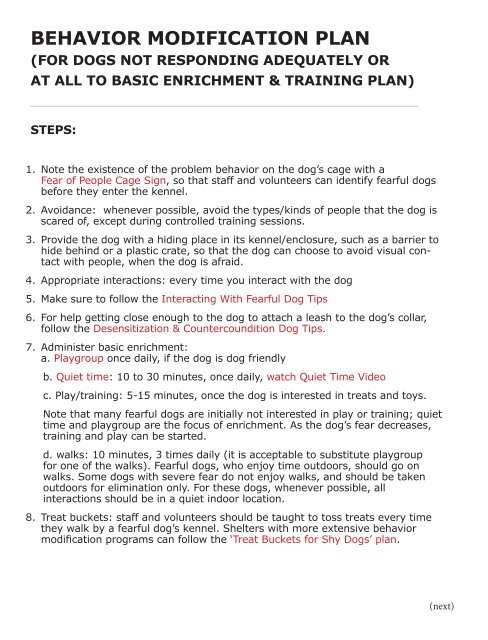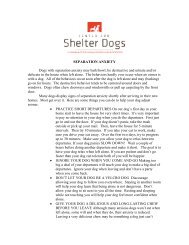BEHAVIOR MODIFICATION PLAN - Center for Shelter Dogs
BEHAVIOR MODIFICATION PLAN - Center for Shelter Dogs
BEHAVIOR MODIFICATION PLAN - Center for Shelter Dogs
Create successful ePaper yourself
Turn your PDF publications into a flip-book with our unique Google optimized e-Paper software.
<strong>BEHAVIOR</strong> <strong>MODIFICATION</strong> <strong>PLAN</strong><br />
(FOR DOGS NOT RESPONDING ADEQUATELY OR<br />
AT ALL TO BASIC ENRICHMENT & TRAINING <strong>PLAN</strong>)<br />
STEPS:<br />
1. Note the existence of the problem behavior on the dog’s cage with a<br />
Fear of People Cage Sign, so that staff and volunteers can identify fearful dogs<br />
be<strong>for</strong>e they enter the kennel.<br />
2. Avoidance: whenever possible, avoid the types/kinds of people that the dog is<br />
scared of, except during controlled training sessions.<br />
3. Provide the dog with a hiding place in its kennel/enclosure, such as a barrier to<br />
hide behind or a plastic crate, so that the dog can choose to avoid visual contact<br />
with people, when the dog is afraid.<br />
4. Appropriate interactions: every time you interact with the dog<br />
5. Make sure to follow the Interacting With Fearful Dog Tips<br />
6. For help getting close enough to the dog to attach a leash to the dog’s collar,<br />
follow the Desensitization & Countercoundition Dog Tips.<br />
7. Administer basic enrichment:<br />
a. Playgroup once daily, if the dog is dog friendly<br />
b. Quiet time: 10 to 30 minutes, once daily, watch Quiet Time Video<br />
c. Play/training: 5-15 minutes, once the dog is interested in treats and toys.<br />
Note that many fearful dogs are initially not interested in play or training; quiet<br />
time and playgroup are the focus of enrichment. As the dog’s fear decreases,<br />
training and play can be started.<br />
d. walks: 10 minutes, 3 times daily (it is acceptable to substitute playgroup<br />
<strong>for</strong> one of the walks). Fearful dogs, who enjoy time outdoors, should go on<br />
walks. Some dogs with severe fear do not enjoy walks, and should be taken<br />
outdoors <strong>for</strong> elimination only. For these dogs, whenever possible, all<br />
interactions should be in a quiet indoor location.<br />
8. Treat buckets: staff and volunteers should be taught to toss treats every time<br />
they walk by a fearful dog’s kennel. <strong>Shelter</strong>s with more extensive behavior<br />
modification programs can follow the ‘Treat Buckets <strong>for</strong> Shy <strong>Dogs</strong>’ plan.<br />
(next)
IN ADDITION, THE <strong>PLAN</strong> SHOULD INCLUDE:<br />
1. Training sessions during time outdoors:<br />
• Praise/treat or click/treat in order to reward friendly or neutral behavior (not<br />
fearful, not aggressive, but not friendly). Be cautious: some fearful dogs are<br />
afraid of the noise of the clicker. These dogs will need to be desensitized and<br />
counter-conditioned to the clicker be<strong>for</strong>e using it, or you may wish to use praise/<br />
treat instead of click/treat with noise sensitive dogs.<br />
• On walks, when the dog looks at strangers (without aggression) praise/treat or<br />
click treat.<br />
• Stand in low traffic areas outdoors with the dog next to you.<br />
If a stranger passes and the dog looks at them (without aggression), praise/treat<br />
or click/treat. If the dog attempts to move away, allow the dog to move away.<br />
During training, avoid high (people) traffic areas.<br />
• Do NOT allow strangers to approach/pet the dog.<br />
2. Office foster (5 days/week): Reference the Office Foster <strong>for</strong> Shy <strong>Dogs</strong> doc.<br />
ADDITIONAL OPTIONAL EXERCISES:<br />
If your shelter has enough resources, you might consider additional training<br />
exercises to reduce the dog’s fear of people.<br />
1. Target training: Initially train the dog to touch a target, and then train the dog to<br />
touch (target) hands/feet, initially of people the dog knows and then of people to<br />
whom you wish to introduce the dog.<br />
2. Tossing treats (desensitization and counter conditioning): Plan sessions with<br />
volunteers or staff that the dog does NOT know. Ask the helper to gently (no sudden<br />
movements) toss treats toward the dog.<br />
As this treatment plan progresses, the helper should toss treats closer and closer<br />
to their location. The trainer and helper must carefully observe the dog’s body<br />
language <strong>for</strong> signs of stress, fear, or aggression, which would indicate that you are<br />
not appropriately desensitizing the dog. Over time and multiple sessions, if the dog<br />
is demonstrating friendly behavior and voluntarily approaching helpers, helpers can<br />
begin to offer treats from their hand, and eventually begin touching the dog on the<br />
chest or withers.










